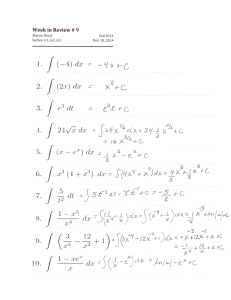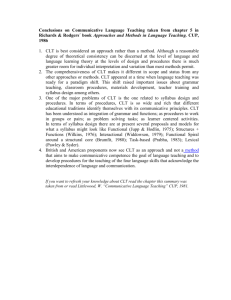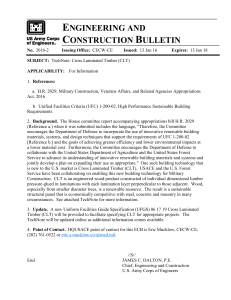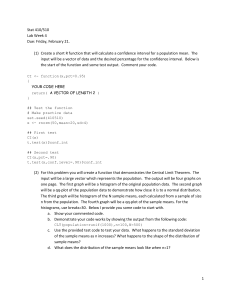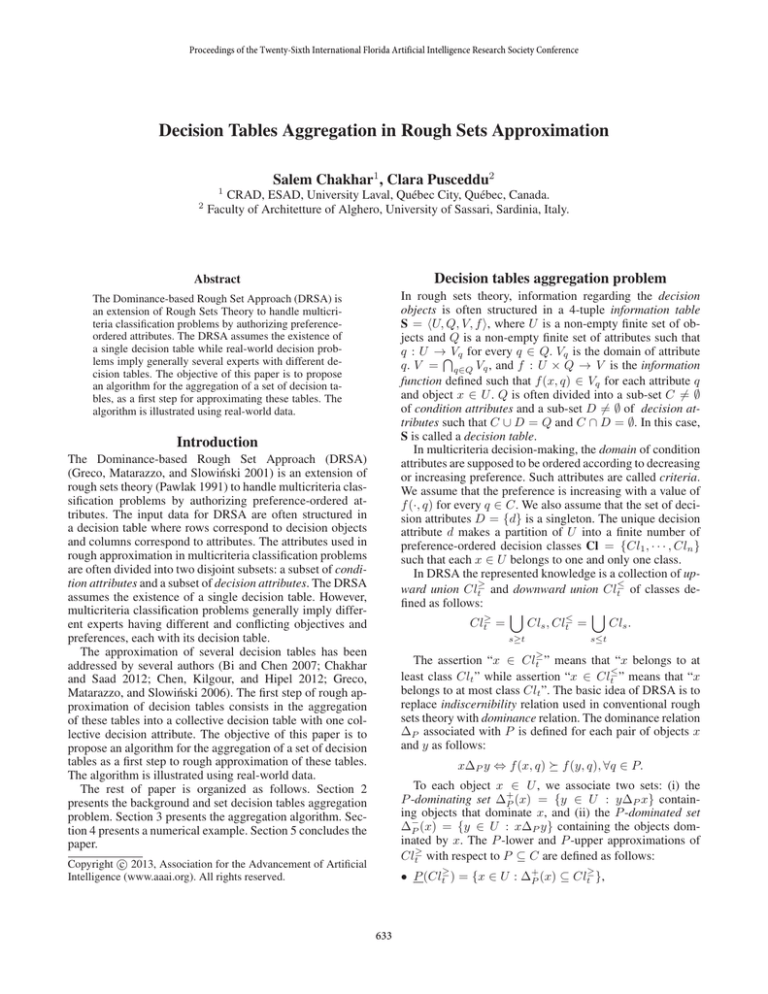
Proceedings of the Twenty-Sixth International Florida Artificial Intelligence Research Society Conference
Decision Tables Aggregation in Rough Sets Approximation
Salem Chakhar1 , Clara Pusceddu2
1
2
CRAD, ESAD, University Laval, Québec City, Québec, Canada.
Faculty of Architetture of Alghero, University of Sassari, Sardinia, Italy.
Abstract
Decision tables aggregation problem
The Dominance-based Rough Set Approach (DRSA) is
an extension of Rough Sets Theory to handle multicriteria classification problems by authorizing preferenceordered attributes. The DRSA assumes the existence of
a single decision table while real-world decision problems imply generally several experts with different decision tables. The objective of this paper is to propose
an algorithm for the aggregation of a set of decision tables, as a first step for approximating these tables. The
algorithm is illustrated using real-world data.
In rough sets theory, information regarding the decision
objects is often structured in a 4-tuple information table
S = hU, Q, V, f i, where U is a non-empty finite set of objects and Q is a non-empty finite set of attributes such that
q : U →TVq for every q ∈ Q. Vq is the domain of attribute
q. V = q∈Q Vq , and f : U × Q → V is the information
function defined such that f (x, q) ∈ Vq for each attribute q
and object x ∈ U . Q is often divided into a sub-set C 6= ∅
of condition attributes and a sub-set D =
6 ∅ of decision attributes such that C ∪ D = Q and C ∩ D = ∅. In this case,
S is called a decision table.
In multicriteria decision-making, the domain of condition
attributes are supposed to be ordered according to decreasing
or increasing preference. Such attributes are called criteria.
We assume that the preference is increasing with a value of
f (·, q) for every q ∈ C. We also assume that the set of decision attributes D = {d} is a singleton. The unique decision
attribute d makes a partition of U into a finite number of
preference-ordered decision classes Cl = {Cl1 , · · · , Cln }
such that each x ∈ U belongs to one and only one class.
In DRSA the represented knowledge is a collection of upward union Clt≥ and downward union Clt≤ of classes defined as follows:
[
[
Clt≥ =
Cls , Clt≤ =
Cls .
Introduction
The Dominance-based Rough Set Approach (DRSA)
(Greco, Matarazzo, and Slowiński 2001) is an extension of
rough sets theory (Pawlak 1991) to handle multicriteria classification problems by authorizing preference-ordered attributes. The input data for DRSA are often structured in
a decision table where rows correspond to decision objects
and columns correspond to attributes. The attributes used in
rough approximation in multicriteria classification problems
are often divided into two disjoint subsets: a subset of condition attributes and a subset of decision attributes. The DRSA
assumes the existence of a single decision table. However,
multicriteria classification problems generally imply different experts having different and conflicting objectives and
preferences, each with its decision table.
The approximation of several decision tables has been
addressed by several authors (Bi and Chen 2007; Chakhar
and Saad 2012; Chen, Kilgour, and Hipel 2012; Greco,
Matarazzo, and Slowiński 2006). The first step of rough approximation of decision tables consists in the aggregation
of these tables into a collective decision table with one collective decision attribute. The objective of this paper is to
propose an algorithm for the aggregation of a set of decision
tables as a first step to rough approximation of these tables.
The algorithm is illustrated using real-world data.
The rest of paper is organized as follows. Section 2
presents the background and set decision tables aggregation
problem. Section 3 presents the aggregation algorithm. Section 4 presents a numerical example. Section 5 concludes the
paper.
s≥t
s≤t
Clt≥ ”
The assertion “x ∈
means that “x belongs to at
least class Clt ” while assertion “x ∈ Clt≤ ” means that “x
belongs to at most class Clt ”. The basic idea of DRSA is to
replace indiscernibility relation used in conventional rough
sets theory with dominance relation. The dominance relation
∆P associated with P is defined for each pair of objects x
and y as follows:
x∆P y ⇔ f (x, q) f (y, q), ∀q ∈ P.
To each object x ∈ U , we associate two sets: (i) the
P -dominating set ∆+
P (x) = {y ∈ U : y∆P x} containing objects that dominate x, and (ii) the P -dominated set
∆−
P (x) = {y ∈ U : x∆P y} containing the objects dominated by x. The P -lower and P -upper approximations of
Clt≥ with respect to P ⊆ C are defined as follows:
c 2013, Association for the Advancement of Artificial
Copyright Intelligence (www.aaai.org). All rights reserved.
≥
• P (Clt≥ ) = {x ∈ U : ∆+
P (x) ⊆ Clt },
633
≥
• P̄ (Clt≥ ) = {x ∈ U : ∆−
P (x) ∩ Clt 6= ∅}.
Analogously, the P -lower and P -upper approximations of
Clt≤ with respect to P ⊆ C are defined as follows:
are respectively the lower and upper classes to which object x can be assigned. Finally, some simple rules are used
to reduce the assignment interval I(x) into a single element
representing the value of the collective decision attribute E.
Before introducing the aggregation algorithm we need to
introduce new concepts. More specifically, the definition of
sets N1 and N2 requires the introduction of three concepts:
concordance power, discordance power and the credibility
indexes. Let first standardize the quality of classifications
γPk (∀k ∈ H) as follows:
≤
• P (Clt≤ ) = {x ∈ U : ∆−
P (x) ⊆ Clt },
≤
• P̄ (Clt≤ ) = {x ∈ U : ∆+
6 ∅}.
P (x) ∩ Clt =
The P -boundaries of Clt≥ and Clt≤ are defined as:
• BnP (Clt≥ ) = P̄ (Clt≥ ) − P (Clt≥ ),
• BnP (Clt≤ ) = P̄ (Clt≤ ) − P (Clt≤ ).
The quality of classification (or approximation) of a partition Cl by means of a set of criteria P is measured by the
ratio γP , which expresses the ratio of all P-correctly classified objects to all objects in the system.
Let H = {1, · · · , i, · · · , h} and let Si = hU, C ∪
{Ei }, V, fi i, ∀i ∈ H be n decision tables where Ei and
fi are respectively the decision attribute and the information function relative to the ith decision table. We assume
that a preference order for U represented by a finite set of
preference-ordered classes
Sni Cli = {Clt,i , t ∈ Ti }, Ti =
{0, · · · , ni }, such that t=1
Clt,i = U , Clt,i ∩ Clr,i = ∅,
∀r, t ∈ T i, r 6= t, and if x ∈ Clr,i , y ∈ Cls,i and r > s,
then x is better than y for the ith decision table. The ni is
the number of decision classes for the ith decision table.
The approximation of the ith decision table Si is characterized, among others, by: (i) the P -lower approximation and
≤
≥
P -boundary of Clt,i
and Clt,i
, for each t ∈ Ti , and (ii) the
quality of classification γPi .
The first step of rough approximation of decision tables
consists in the aggregation of these tables into a collective
decision table with one collective decision attribute. The
problem of decision tables aggregation can be stated as follows: Let Si = hU, C ∪ {Ei }, V, fi i (∀i ∈ H). Then, construct a collective decision table S = hU, C ∪ {E}, V, gi
where E is a decision attribute and g is an information function defined for each x ∈ U as follows:
f (x, q), if q ∈ C,
g(x, q) =
(1)
g(x, E), if q = E.
γk0
=
γPk
Ph
γPr
We assume that ∈ {≥, ≤} and Cl={Cl1 , · · · , Cln }.
(2)
r=1
Concordance power For each x ∈ U and Clt ∈ Cl we
define the set: L(x, Clt ) = {i : i ∈ H ∧ x ∈ P (Clt,i
)}
where P (Clt,i ) is the P -lower approximation of Clt in respect to the ith decision table. Then, the concordance powers for the assignment of x to Clt is then defined as follows.
Definition 1 The concordance power for the assignment of
x to Clt is computed as follows:
S(x, Clt )
=
k=n
X
Sk (x, Clt )
(3)
k=1
where:
Sk (x, Clt )
=
γk0 , if k ∈ L(x, Clt ),
0,
otherwise.
(4)
Discordance power For each x ∈ U and Clt ∈ Cl we
define the set B(x, Clt ) = {i : i ∈ H ∧ x ∈ BnP (Clt,i
)}
where BnP (Clt,i ) is the boundary of Clt in respect to the
ith decision table. Then, the discordance powers for the assignment of x to the boundary of Clt is defined as follows.
Definition 2 The discordance power for the assignment of
x to Clt is computed as follows:
Z(x, Clt )
=
k=n
Y
Zk (x, Clt )
(5)
k=1
The decision attribute E induces a partition of U into a
set of decision classes Cl = {Cl1 , · · · , Cln } such that each
x ∈ U belongs to one and only one class Clt ∈ Cl. To define
S it suffices to specify the values of g(x, E) for all x ∈ U .
where
1−γk0
1−S(x,Clt ) ,
if γk0 > S(x, Clt )∧
=
k ∈ B(x, Clt ), (6)
1,
otherwise.
We may distinguish two cases in the definition of the discordance power. The first case holds when γk0 ≤ S(x, Clt ),
which leads to Zk (x, Clt ) = 1. In this case, there is no
veto effect for decision maker k and Zk (x, Clt ) will have
no effect on the definition of overall discordance power
Z(x, Clt ) and on the value of the credibility indexes as explained in the next paragraph. The second case holds when
γk0 > S(x, Clt ), which leads to 0 < Zk (x, Clt ) < 1. Here,
decision maker k do have a veto effect and Zk (x, Clt ) will
have an effect on the value of overall discordance power
Z(x, Clt ) and on the value of the credibility indexes as explained later.
Zk (x, Clt )
Decision tables aggregation algorithm
As stated above, the objective of the aggregation algorithm
is to construct a decision table S by aggregating the decision
tables S1 , · · · , Sh . The idea of the aggregation algorithm is
to use the upward and downward approximation of unions of
classes in order to identify the possible assignments classes
for each decision object. Two sets will be constructed: (i)
set N1 contains the possible assignments obtained based on
the upward approximation of unions of classes; and (ii) set
N2 contains the possible assignments obtained based on the
downward approximation of unions of classes. These sets
will then be used to associate to each object x ∈ U an assignment interval I(x) = [l(x), u(x)] where l(x) and u(x)
634
Reduction of the assignment interval Let I(x) =
[l(x), u(x)] be the assignment interval for object x ∈ U
defined as previously. Two cases hold for the reduction of
I(x). The first case holds when l(x) = u(x). Here, object
x is assigned to a single class and consequently we can set
g(x, E) = l(x) (or g(x, E) = u(x)). The second case holds
when l(x) < u(x). This corresponds to the situation where
object x can be assigned to more than one class. To specify
the value of g(x, E) when the second case holds we may
apply one of the following rules to reduce the collective assignment interval I(x) to a single class: the minimum value,
the maximum value, the median value, the floor of the median value and the ceil of the median value.
Credibility indexes Using the concordance and discordance powers, we may define the credibility index for assigning x to Clt as follows.
Definition 3 Let x ∈ U and ∈ {≥, ≤}. The credibility indexes for the assignment of x to Clt is computed as follows:
σ(x, Clt )
= S(x, Clt ) · Z(x, Clt )
(7)
This formula can be explained as follows. If there is no
support for the assignment of x to Clt , i.e., S(x, Clt ) = 0,
then the credibility indexes will be σ(x, Clt ) = 0. In turn,
if there is a full support, i.e., S(x, Clt ) = 1 (which imposes that Z(x, Clt ) = 1), then credibility indexes will be
σ(x, Clt ) = 1. Finally, if there is a partial support, i.e., 0 <
S(x, Clt ) < 1 (which imposes that 0 < Z(x, Clt ) ≤ 1),
then 0 < σ(x, Clt ) < 1. In the last case, we may distinguish two subcases, according to the verification or not of
the condition γk0 > S(x, Clt ). The first subcase holds when
the condition γk0 > S(x, Clt ) is not verified. This leads
to Z(x, Clt ) = 1 and then σ(x, Clt ) = S(x, Clt ) < 1.
In this subcase, the credibility index is simply equal to the
concordance power; hence the discordance power will have
no effect on the value of the credibility indexes σ(x, Clt ).
The second subcase holds when condition γk0 > S(x, Clt )
is verified. This leads to Z(x, Clt ) < 1 and consequently
σ(x, Clt ) = S(x, Clt ) · Z(x, Clt ) < 1. In this subcase, the
credibility index is obtained by decreasing the concordance
power S(x, Clt ) proportionally to the value of the discordance power Z(x, Clt ).
Aggregation algorithm The aggregation procedure is formalized in Algorithm 1. This algorithm works as follows. It
loops on the set of decision objects and for each object: (i)
computes the credibly indexes for upward unions of classes
(the first inner for loop); (ii) computes the credibly indexes
for downward unions of classes (the second inner for loop));
(iii) computes the assignment interval I(x) = [l(x), u(x)];
and (vi) computes the values of the collective decision attribute E.
Functions SigmaUpward and SigmaDownward permit to compute the credibility indexes and function
IntervalReduction permits to compute the assignment interval.
Application
Definition of assignment interval Let λ ∈ [0.5, 1] be a
credibility threshold. Then, based on the credibility indexes,
we may define the sets N1 and N2 as follows.
We consider a real-world data relative to the management
of post-accident nuclear risk in the PRIME project (Chakhar
and Saad 2012). The problem involves 18 decision objects
and 7 attributes (radioecological vulnerability of agricultural
area (A1 ), radioecological vulnerability of forest area (A2 ),
radioecological vulnerability of urban area (A3 ), real estate
vulnerability (A4 ), Tourism vulnerability (A5 ), economic
vulnerability of companies (A6 ), and employment vulnerability (A7 )).
The main input is three decision tables summarized in
Table 1. Each object is described in terms of seven condition attributes (A1 , A2 , · · ·, and A7 ) and three decision attributes (E1 , E2 , and E3 ). The values of condition attributes
correspond to vulnerability levels. The values of decision attributes correspond to the global vulnerability levels as specified by three experts. All condition and decision attributes
are evaluated on a six-level ordinal scale (from normal situation (0) to major and long-lasting negative impact (5)).
The software 4eMka2 (which implements the DRSA) is
used to approximate the individual decision tables. The outputs of individual approximations are then complied in a single .txt file and provided as input to a prototype implementing the aggregation algorithm.
The credibility indexes values computed using Equation
(7) are given in Table 2. The assignment intervals along with
the application of interval reduction rules are given in Table
3.
Definition 4 The credibility indexes, we may define the sets
N1 and N2 as follows:
• N1 (x) = {Clt : x ∈ U ∧ σ(x, Clt≥ ) ≥ λ},
• N2 (x) = {Clt : x ∈ U ∧ σ(x, Clt≤ ) ≤ λ}.
Then, the idea for the definition of assignment intervals
is to constraint possible assignment classes by the content
of sets N1 (x) and N2 (x). Indeed, the set N1 (x) is defined
based on the upward union of classes Clt≥ ; it should be used
to define the lower limit l(x) of the assignment interval of x.
In turn, the set N2 (x) is defined based on downward union
of classes Clt≤ ; it should be used to define the upper limit
u(x) of the assignment interval of x.
Definition 5 Let x ∈ U . Then, we associate to each object
x an assignment interval I(x) = [l(x), u(x)] where:
l(x)
=
u(x)
=
argmaxClt N1 (x), if N1 (x) 6= ∅,
Cl0 ,
otherwise.
(8)
argminClt N2 (x), if N2 (x) 6= ∅,
Cln ,
otherwise.
(9)
635
Input : I // where I = hU, C, V, f i is the common decision table.
S1 , · · · , Sh //where Si = hU, C ∩ {Ei }, V, fi i.
λ // where λ ∈ [0.5, · · · , 1] is the credibility threshold.
ir− rule // where ir − rule is the interval reduction rule.
def ault− rule // default rule to use when “median” rule do not apply.
Output: S // where S = hU, C ∩ E, V, gi is the aggregated decision table.
E ←− decision attribute;
Q ←− C ∪ {E};
H ←− {1, 2, · · · , h}
for (all x ∈ U) do
//...computes the credibly indexes for upward unions of classes...
N1 (x) ←− ∅;
for (all t ∈ {1, 2, · · · , n}) do
≥
←− SigmaUpward(S1 , · · · , Sh , t, x);
σ
x, Clt
if
σ(x, Clt ) ≥ λ then
N1 ←− N1 ∪ Clt ;
end
≥
A2
5
5
5
5
2
1
2
2
2
3
3
3
2
2
2
2
1
1
A3
5
5
5
5
2
1
1
1
2
3
3
2
2
2
1
1
1
0
A4
5
5
5
5
4
2
2
2
4
4
4
4
4
4
4
4
2
1
A5
4
4
4
4
4
4
4
2
4
4
4
4
4
4
3
4
4
4
A6
1
2
2
3
2
1
1
1
2
1
1
1
1
1
1
1
1
1
A7
1
2
1
1
0
0
0
0
0
0
0
0
0
0
0
0
0
0
E1
4
4
4
5
3
0
3
0
3
3
3
3
2
2
2
2
3
3
E2
4
4
4
4
2
0
2
0
2
2
2
2
2
1
1
1
3
3
E3
5
5
5
5
3
1
2
1
2
3
3
3
3
2
2
2
4
3
Table 1: Information table with assignment examples
end
//...computes the credibly indexes for downward unions of classes...
N2 (x) ←− ∅;
for (all t ∈ {0, 1, · · · , n − 1}) do
≤
x, Clt
if
σ(x, Clt ) ≥ λ then
N2 ←− N2 ∪ Clt ;
≤
Object
xi
x1
x2
x3
x4
x5
x6
x7
x8
x9
x10
x11
x12
x13
x14
x15
x16
x17
x18
←− SigmaDownward(S1 , · · · , Sh , t, x);
σ
end
A1
4
4
4
4
3
1
2
1
3
3
3
3
3
2
2
2
1
1
Object
x1
x2
x3
x4
x5
x6
x7
x8
x9
x10
x11
x12
x13
x14
x15
x16
x17
x18
Algorithm 1: Aggregation
end
//...computes the assignment interval I(x) = [l(x), u(x)]...
l(x) ←− Cl0 ;
u(x) ←− Cln ;
if (N1 =
6 ∅) then
l(x) ←− argmaxCl N1 (x);
t
end
if (N2 =
6 ∅) then
u(x) ←− argminCl N2 (x);
t
end
//...computes the values of the collective decision attribute g(x, E)...
for (all q ∈ C) do
g (x, q) ←− f (x, q);
end
if ( l(x) = u(x)) then
g(x, E) ←− l(x);
end
else
g(x, E) ←−
IntervalReduction(l(x), u(x), ir− rule, def ault− rule);
end
≥
t
1
1
1
1
1
1
0.18
1
0.26
1
1
1
1
1
1
1
1
0.183
0.183
σ(xi , Clt )
2
3
4
1
1
1
1
1
1
1
1
1
1
1
1
1
0.48 0
0
0
0
0.74 0
0
0
0
0
1
0.48 0
1
0.74 0
1
0.74 0
1
0.74 0
1
0
0
0.74 0
0
0.74 0
0
0.74 0
0
0
0
0
0
0
0
≤
5
0.26
0.26
0.26
0.74
0
0
0
0
0
0
0
0
0
0
0
0
0
0
0
0
0
0
0
0
0
0
0.74
0
0
0
0
0
0
0
0
0
0
σ(xi , Clt )
1
2
3
0
0
0
0
0
0
0
0
0
0
0
0
0
0
0.74
0
0
0.74
0
0
0.74
1
1
1
0
0
0.74
0
0
0.74
0
0
0.74
0
0
0.74
0
0
0.74
0
0
0.74
0.26 1
1
0
0
0.74
0
0
0.74
0
0
1
4
0.74
0.74
0.74
0.26
1
1
1
1
1
1
1
1
1
1
1
1
1
1
Table 2: Credibility indexes values
Object xi
x1
x2
x3
x4
x5
x6
x7
x8
x9
x10
x11
x12
x13
x14
x15
x16
x17
x18
end
S ←−< U, Q, V, g >;
return S
Conclusion
We proposed an algorithm for the approximation of a set of
decision tables. The algorithm is illustrated using real-world
data. In the future, we intend to study the mathematical properties of the introduced concepts. We also intend to conceive
and to develop a full-featured decision support system supporting the aggregation algorithm.
l(x)
4
4
4
5
2
0
2
0
2
3
3
3
2
2
2
2
0
0
u(x)
4
4
4
5
3
4
4
0
3
3
3
3
3
3
2
3
3
3
min
4
4
4
5
2
0
2
0
2
3
3
3
2
2
2
2
0
0
max
4
4
4
5
3
4
4
0
3
3
3
3
3
3
2
3
3
3
floor
4
4
4
5
2
2
3
0
2
3
3
3
2
2
2
2
1
1
ceil
4
4
4
5
3
3
3
0
3
3
3
3
3
3
2
3
2
2
Table 3: Collective decision attribute E values for λ = 0.70
Greco, S.; Matarazzo, B.; and Slowiński, R. 2001. Rough
sets theory for multicriteria decision analysis. European
Journal of Operational Research 129(1):1–47.
Greco, S.; Matarazzo, B.; and Slowiński, R.
2006.
Dominance-based rough set approach to decision involving
multiple decision makers. In Proceedings of the 5th International Conference Rough Sets and Current Trends in Computing, Kobe, Japan, November 6-8, LNAI 4259. 306–317.
Pawlak, Z. 1991. Rough set. Theoretical aspects of reasoning about data. Dordrecht: Kluwer Academic Publishers.
References
Bi, W.-J., and Chen, X.-H. 2007. An extended dominancebased rough set approach to group decision. In Proceedings of the International Conference on Wireless Communications, Networking and Mobile Computing, 5753–5756.
Chakhar, S., and Saad, I. 2012. Dominance-based rough set
approach for groups in multicriteria classification problems.
Decision Support Systems 54(1):372–380.
Chen, Y.; Kilgour, D.; and Hipel, K. 2012. A decision rule
aggregation approach to multiple criteria-multiple participant sorting. Group Decision and Negotiation 21:727–745.
636

